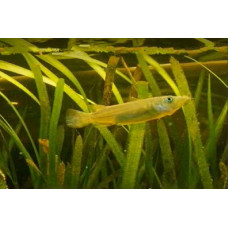Halfbeak (Hemiramphidae) is a family of fishes of the Beloniformes. The body is elongated, arrow-shaped. The mouth is small. The upper jaw is short. The lower one protrudes forward, forming a protrusion. Marine, brackish-water and freshwater fish inhabiting tropical and subtropical coastal waters of the World Ocean, in fresh and brackish waters of Asia.
Received its name due to the uneven development of the jaws: the upper jaw they are short, and the lower, as a rule, to varying degrees elongated (although, in some genera very slightly). Halfbeak are also characterized by a small mouth, fairly large scales and short pectoral fins.Halfbeak have a dark blue or brownish back and silver sides and belly, and along the midline of the body often runs a dark band, casting a metallic sheen.
The family Halfbeak includes about 10 genera with 60 species. These are small and medium-sized fish (6-7 to 60 cm long), leading a gregarious lifestyle and feed on plankton and small fish. There are suggestions that the long lower jaw is used by half-fish as a tool with which they give their prey whipping blows. These fish are usually kept near the surface of the water and when frightened are often thrown into the air, and some species can jump to the surface, leaving in the water only the lower part of the tail fin, and quickly glide on it, overcoming in this way quite a long distance (up to 70 m). This peculiarity of biology during the evolution of the group probably served as the basis for the transition to true flight in the air. Halfbeak are found in marine, brackish and fresh waters. Marine species inhabit predominantly coastal areas, with some occasionally entering even desalinated estuaries and bays. They are particularly characteristic of tropical and subtropical waters, outside of which they are extremely rare. One of the few exceptions is the distribution of Nurorhamphus sajori, which inhabits the coasts of Japan (north to Hokkaido) and Korea and enters the waters of the Russian Primorye (Peter the Great Bay, South Sakhalin) in summer. The Japanese Halfbeak reaches a length of 25 cm. Like other Halfbeaks, it has quite edible and quite tasty meat, but its commercial value is low.
Halfbeak are very rare in open ocean waters, except when they accompany drifting algal aggregations. Only two species, Euleptorhamphus viridis and Ochurorhamphus micropterus, are permanent inhabitants of the open ocean pelagial, the latter even breeding far from the coast. Unlike other Halfbeak, which lay eggs on vegetation, equipped with filamentous growths, this species has buoyant eggs, passing development in the water column. These species have fairly large pectoral fins and have the ability to plan flight over the water, carried out on the same principle as the flight of flying fish, but less perfect. Euleptorhamphus viridis can fly up to 50 m, and during the flight of the elongated body of the fish maintains a straight position only in the front part, and the rear half of the body under the influence of its own gravity is strongly bent downward. The maximum range of flight of Euleptorhamphus viridis, which does not have an elongated mandible and even in appearance strongly resembles a real flying fish with small "wings", also does not exceed, apparently, 50-60 meters.
Unlike the marine Halfbeak, which inhabit tropical and subtropical waters around the world, freshwater species are found only in rivers of South and Southeast Asia and Northern Australia. They are generally smaller in size than their marine relatives. Dermogenys pusillus, for example, does not reach more than 7, 5 cm in length, and sexually mature becomes already at a length of 5 cm. This fish, whose homeland rivers and brackish water bodies of Indonesia (Java, Sumatra, Kalimantan), the Malacca Peninsula and Thailand, is bred and aquarists. Like other freshwater species of this family, Dermogenys pusillus belongs to the number of viviparous fish. The female after eight weeks of lactation brings 12-20 fry with a length of less than 1 cm at birth.
Marine Halfbeak, feed on algae, sea grass, plankton, invertebrates (pteropods, crustaceans) and small fish. In some subtropical species, juveniles are more predatory than adults. Some tropical species eat animal food during the day and plant food at night, while other species switch from carnivorous food in summer to plant food in winter. Freshwater species are more carnivorous than marine species. Usually stay upstream and feed on insect larvae carried by the current and airborne insects that fall on the water surface, especially mosquitoes and spiders. They serve as food for many fish (marlins, mackerels, sharks).
Halfbeak
Tags: halfbeak



